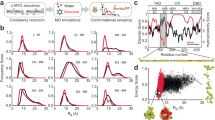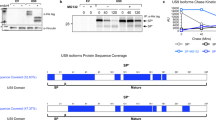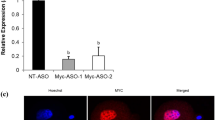Abstract
Avian retroviruses that have transduced c-myc are useful tools to study the conditions necessary for cellular transformation. FH3, one such retrovirus which encodes a Gag-Myc fusion protein, is not transforming in quail embryonic fibroblasts, but a late variant of FH3 that arose after passaging FH3-infected cells is transforming. Mutational analysis of FH3 revealed that the presence of a portion of the retroviral protease in FH3 inhibited transformation and that this inhibition was transferable to a more highly transforming retrovirus, MC29. Transforming and non-transforming FH3-derived and MC29-derived Gag-Myc proteins were used to further explore characteristics of Myc necessary for transformation. Gag-Myc proteins which were transforming were found to be the most stable in the cell. To distinguish whether transactivation and/or repression is correlated to transformation, the various Gag-Myc fusion proteins were tested for their ability to activate or repress c-Myc targets. Results indicated that a correlation exists between transforming Gag-Myc proteins and their ability to repress, whereas all Gag-Myc proteins could transactivate, regardless of their ability to transform. Taken together, these results suggest that protein stabilization of Myc and repression of target genes by Myc are important for cellular transformation.
This is a preview of subscription content, access via your institution
Access options
Subscribe to this journal
Receive 50 print issues and online access
$259.00 per year
only $5.18 per issue
Buy this article
- Purchase on SpringerLink
- Instant access to full article PDF
Prices may be subject to local taxes which are calculated during checkout






Similar content being viewed by others
References
Alitalo K, Bishop JM, Smith DH, Chen EY, Colby WW and Levinson AD. . 1983 Proc. Natl. Acad. Sci. USA 80: 100–104.
Amundson SA, Zhan Q, Penn LZ and Fornace Jr AJ. . 1998 Oncogene 17: 2149–2154.
Auvinen M, Paasinen A, Andersson LC and Holtta E. . 1992 Nature 360: 355–358.
Bello-Fernandez C, Packham G and Cleveland JL. . 1993 Proc. Natl. Acad. Sci. USA 90: 7804–7808.
Biegalke BJ and Geballe AP. . 1990 Virology 177: 657–667.
Blackwell TK, Huang J, Ma A, Kretzner L, Alt FW, Eisenman RN and Weintraub H. . 1993 Mol. Cell. Biol. 13: 5216–5224.
Brasier AR and Fortin JJ. . 1995 Current Protocols in Molecular Biology. Ausubel FM, Brent R, Kingston RE, Moore DD, Seidman JG, Smith JA and Struhl K. (eds). John Wiley & Sons: Boston, MA pp. 9.7.12–9.7.21.
Brough DE, Hofmann TJ, Ellwood KB, Townley RA and Cole MD. . 1995 Mol. Cell. Biol. 15: 1536–1544.
Bush A, Mateyak M, Dugan K, Obaya A, Adachi S and Cole M. . 1998 Genes Dev. 12: 3797–3802.
Campanero MR and Flemington EK. . 1997 Proc. Natl. Acad. Sci. USA 94: 2221–2226.
Campbell S and Vogt VM. . 1995 J. Virol. 69: 6487–6497.
Chang DW, Claassen G, Hann SR and Cole MD. . 2000 Mol. Cell. Biol. 20: 4309–4319.
Chen C, Biegalke BJ, Eisenman RN and Linial ML. . 1989 J. Virol. 63: 5092–5100.
Chen CA and Okayama H. . 1996 Current Protocols in Molecular Biology. Ausubel FM, Brent R, Kingston RE, Moore DD, Seidman JG, Smith JA and Struhl K. (eds). John Wiley & Sons: Boston, MA pp. 9.1.7–9.1.9.
Claassen GF and Hann SR. . 1999 Oncogene 18: 2925–2933.
Coffin JM. . 1996 Virology. Fields BN, Knipe DM and Howley PM. (eds). Lippincott-Raven: Philadelphia, PA pp. 1767–1847.
Cohn SL, Salwen H, Quasney MW, Ikegaki N, Cowan JM, Herst CV, Kennett RH, Rosen ST, DiGiuseppe JA and Brodeur GM. . 1990 Oncogene 5: 1821–1827.
Crouch DH, Lang C and Gillespie DA. . 1990 Oncogene 5: 683–689.
Dang CV and Lee WM. . 1988 Mol. Cell. Biol. 8: 4048–4054.
Dib-Hajj F, Khan R and Giedroc DP. . 1993 Protein Sci. 2: 231–243.
Dupraz P and Spahr PF. . 1992 J. Virol. 66: 4662–4670.
Fornace AJJ, Alamo IJ and Hollander MC. . 1988 Proc. Natl. Acad. Sci. USA 85: 8800–8804.
Fornace AJJ, Nebert DW, Hollander MC, Luethy JD, Papathanasiou M, Fargnoli J and Holbrook NJ. . 1989 Mol. Cell. Biol. 9: 4196–4203.
Frykberg L, Graf T and Vennstrom B. . 1987 Oncogene 1: 415–422.
Fu XD, Katz RA, Skalka AM and Leis J. . 1988 J. Biol. Chem. 263: 2140–2145.
Gavine PR, Neil JC and Crouch DH. . 1999 Oncogene 18: 7552–7558.
Gelfand CA, Wang Q, Randall S and Jentoft JE. . 1993 J. Biol. Chem. 268: 18450–18456.
Grinde B, Cameron CE, Leis J, Weber IT, Wlodawer A, Burstein H, Bizub D and Skalka AM. . 1992 J. Biol. Chem. 267: 9481–9490.
Hann SR and Eisenman RN. . 1984 Mol. Cell. Biol. 4: 2486–2497.
Hateboer G, Kerkhoven RM, Shvarts A, Bernards R and Beijersbergen RL. . 1996 Genes Dev. 10: 2960–2970.
Hayflick J, Seeburg PH, Ohlsson R, Pfeifer-Ohlsson S, Watson D, Papas T and Duesberg PH. . 1985 Proc. Natl. Acad. Sci. USA 82: 2718–2722.
Hayward WS, Neel BG and Astrin SM. . 1981 Nature 290: 475–480.
Henriksson M and Luscher B. . 1996 Adv. Cancer Res. 68: 109–182.
Hofmann F, Martelli F, Livingston DM and Wang Z. . 1996 Genes Dev. 10: 2949–2959.
Karpel RL, Henderson LE and Oroszlan S. . 1987 J. Biol. Chem. 262: 4961–4967.
Kato GJ, Barrett J, Villa-Garcia M and Dang CV. . 1990 Mol. Cell. Biol. 10: 5914–5920.
Land H, Parada LF and Weinberg RA. . 1983 Nature 304: 596–602.
Lee CM and Reddy EP. . 1999 Oncogene 18: 2997–3003.
Lee LA and Dang CV. . 1997 Curr. Top. Microbiol. Immunol. 224: 131–135.
Lee LA, Dolde C, Barrett J, Wu CS and Dang CV. . 1996 J. Clin. Invest. 97: 1687–1695.
Li LH, Nerlov C, Prendergast G, MacGregor D and Ziff EB. . 1994 EMBO J. 13: 4070–4079.
Linial M. . 1982 Virology 119: 382–391.
Linial M and Groudine M. . 1985 Proc. Natl. Acad. Sci. USA 82: 53–57.
Loeb DD, Swanstrom R, Everitt L, Manchester M and Hutchison CA3. . 1989 Nature 340: 397–400.
Luscher B, Kuenzel EA, Krebs EG and Eisenman RN. . 1989 EMBO J. 8: 1111–1119.
Mao Y, Gurr JA and Hickok NJ. . 1993 Biochem. J. 295: 641–644.
Marhin WW, Chen S, Facchini LM, Fornace AJJ and Penn LZ. . 1997 Oncogene 14: 2825–2834.
McMahon SB, Wood MA and Cole MD. . 2000 Mol. Cell. Biol. 20: 556–562.
Meichle A, Philipp A and Eilers M. . 1992 Biochim. Biophys. Acta. 1114: 129–146.
Min S and Taparowsky EJ. . 1992 Oncogene 7: 1531–1540.
Mladenov Z, Heine U, Beard D and Beard JW. . 1967 J. Natl. Cancer. Inst. 38: 251–285.
Moshier JA, Dosescu J, Skunca M and Luk GD. . 1993 Cancer Res. 53: 2618–2622.
Oertle S, Bowles N and Spahr PF. . 1992 J. Virol. 66: 3873–3878.
Pena A, Reddy CD, Wu S, Hickok NJ, Reddy EP, Yumet G, Soprano DR and Soprano KJ. . 1993 J. Biol. Chem. 268: 27277–27285.
Penn LJ, Brooks MW, Laufer EM and Land H. . 1990a EMBO J. 9: 1113–1121.
Penn LJ, Brooks MW, Laufer EM, Littlewood TD, Morgenstern JP, Evan GI, Lee WM and Land H. . 1990b Mol. Cell. Biol. 10: 4961–4966.
Petropoulos CJ and Hughes SH. . 1991 J. Virol. 65: 3728–3737.
Peukert K, Staller P, Schneider A, Carmichael G, Hanel F and Eilers M. . 1997 EMBO J. 16: 5672–5686.
Reddy EP, Reynolds RK, Watson DK, Schultz RA, Lautenberger J and Papas TS. . 1983 Proc. Natl. Acad. Sci. USA 80: 2500–2504.
Salghetti SE, Kim SY and Tansey WP. . 1999 EMBO J. 18: 717–726.
Schneider A, Peukert K, Eilers M and Hanel F. . 1997 Curr. Top. Microbiol. Immunol. 224: 137–146.
Sears R, Leone G, DeGregori J and Nevins JR. . 1999 Mol. Cell. 3: 169–179.
Selten G, Cuypers HT and Berns A. . 1985 EMBO J. 4: 1793–1798.
Shindo H, Tani E, Matsumuto T, Hashimoto T and Furuyama J. . 1993 Acta. Neuropathol. 86: 345–352.
Tikhonenko AT and Linial ML. . 1992 J. Virol. 66: 946–955.
Tikhonenko AT and Linial ML. . 1993 J. Virol. 67: 3635–3638.
Vairapandi M, Balliet AG, Fornace AJJ, Hoffman B and Liebermann DA. . 1996 Oncogene 12: 2579–2594.
Vogt VM. . 1996 Curr. Top. Microbiol. Immunol. 214: 95–131.
Wagner AJ, Meyers C, Laimins LA and Hay N. . 1993 Cell Growth Differ. 4: 879–883.
Walther N, Jansen HW, Trachmann C and Bister K. . 1986 Virology 154: 219–223.
Walther N, Lurz R, Patschinsky T, Jansen HW and Bister K. . 1985 J. Virol. 54: 576–585.
Watson DK, Psallidopoulos MC, Samuel KP, Dalla-Favera R and Papas TS. . 1983 Proc. Natl. Acad. Sci. USA 80: 3642–3645.
Zhan Q, Chen IT, Antinore MJ and Fornace Jr AJ. . 1998 Mol. Cell. Biol. 18: 2768–2778.
Zhan Q, Lord KA, Alamo IJ, Hollander MC, Carrier F, Ron D, Kohn KW, Hoffman B, Liebermann DA and Fornace Jr AJ. . 1994 Mol. Cell. Biol. 14: 2361–2371.
Acknowledgements
We thank Bob Eisenman and Mark Groudine for critical reading of the manuscript, and Carla Grandori and Carol Laherty for insightful discussions. This work was supported by research grants R01 CA-18282 and CA-58809 from the National Cancer Institute to ML Linial. W Law was partially supported by training grant 5 T32 CA-09657 from the National Institutes of Health.
Author information
Authors and Affiliations
Rights and permissions
About this article
Cite this article
Law, W., Linial, M. Transforming ability of Gag-Myc fusion proteins correlates with Gag-Myc protein stability and transcriptional repression. Oncogene 20, 1118–1127 (2001). https://doi.org/10.1038/sj.onc.1204226
Received:
Revised:
Accepted:
Published:
Issue date:
DOI: https://doi.org/10.1038/sj.onc.1204226



